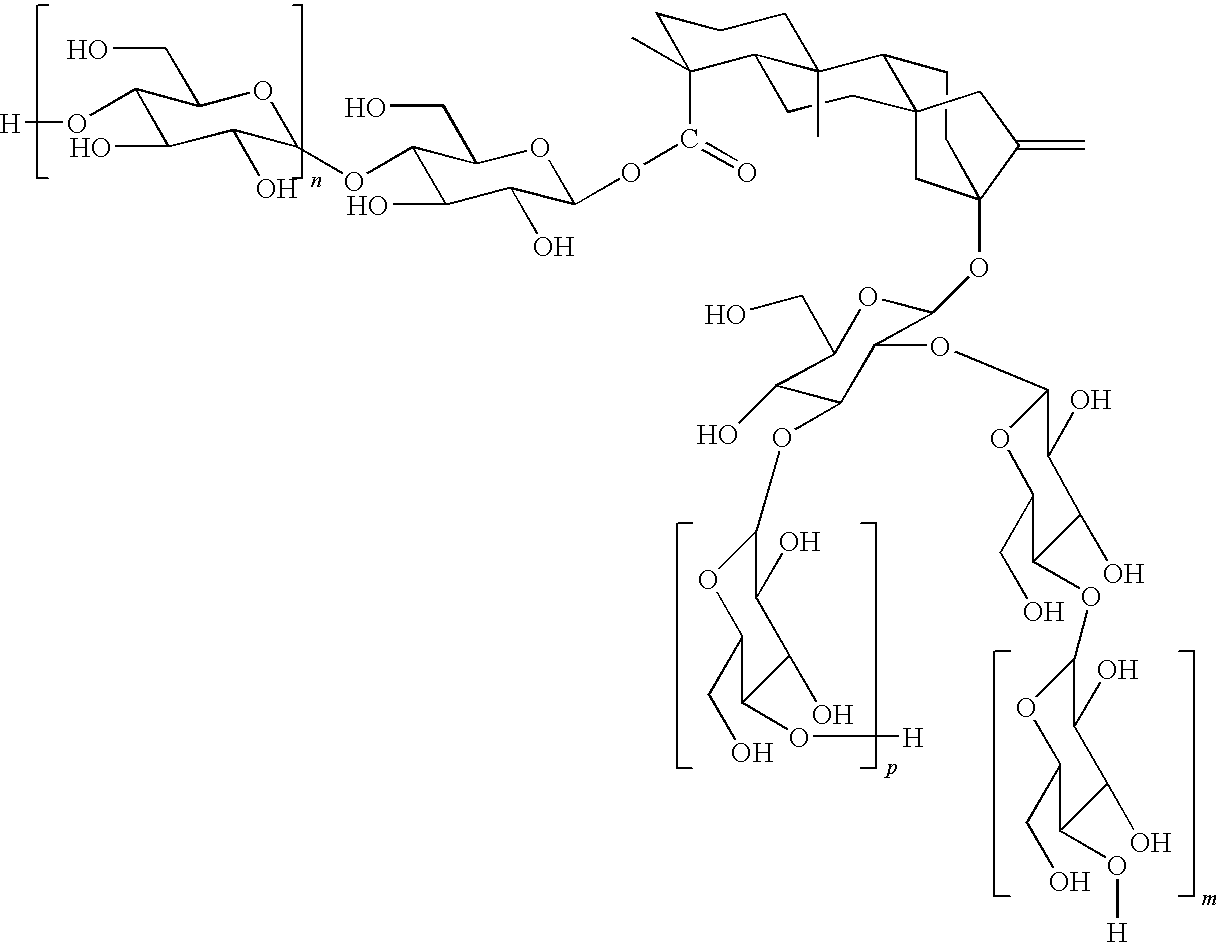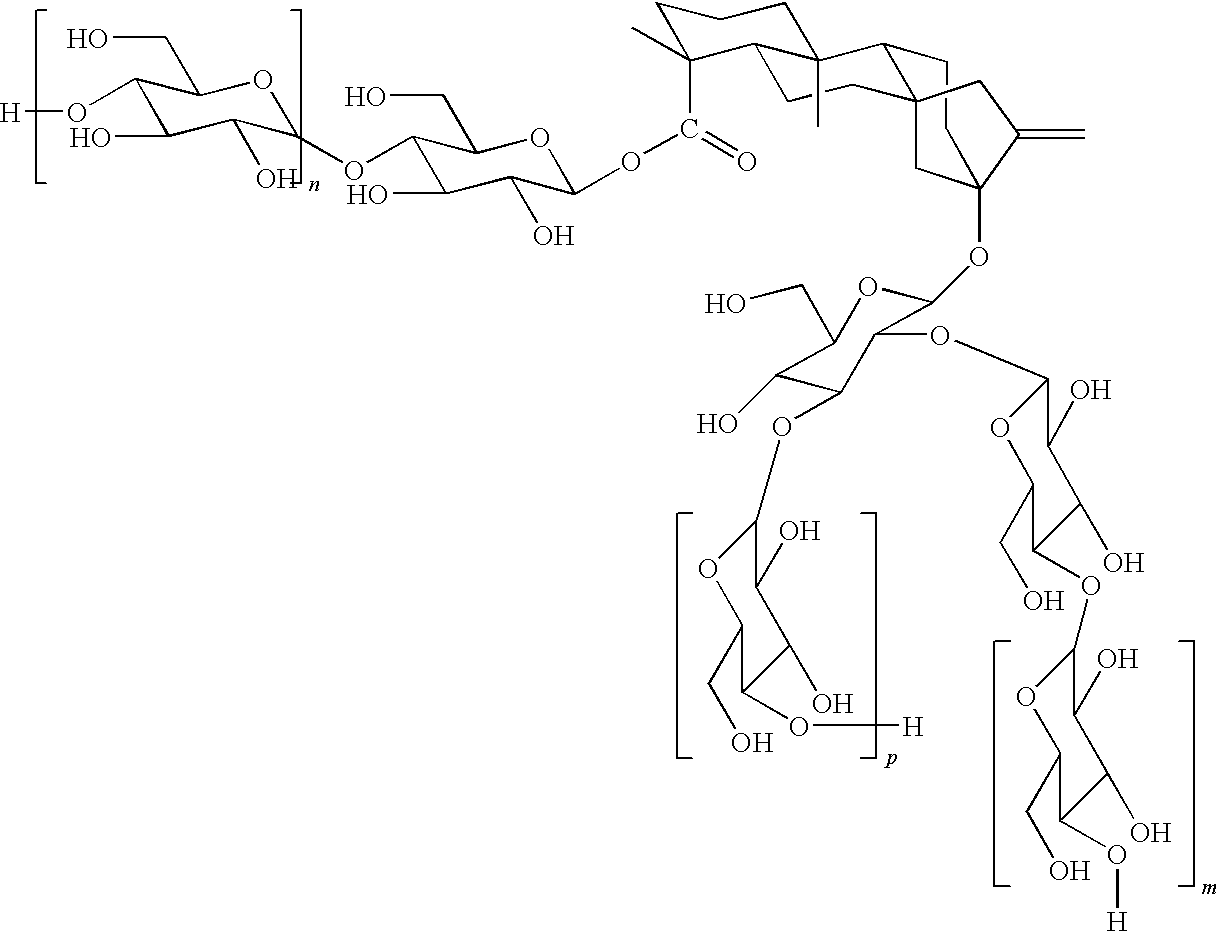Use of erythritol and D-tagatose in diet or reduced-calorie beverages and food products
a technology of erythritol and dtagatose, which is applied in the field of diet or reduced-calorie beverages and food products, can solve the problems of low taste of reduced-calorie beverages, lack of body and/or thickness perception of full-calorie beverages, and inability to achieve a taste similar to full-calorie products. achieve the effect of reducing calorie beverages
- Summary
- Abstract
- Description
- Claims
- Application Information
AI Technical Summary
Benefits of technology
Problems solved by technology
Method used
Image
Examples
example 1
[0048]A 2-liter syrup for use in making a finished cola drink was prepared. The ingredients listed in Table 1 were added in sequence to approximately 1-1.5 L purified water with stirring.
[0049]
TABLE 1Ingredient(g)sodium benzoate2.04phosphoric acid4.41caffeine1.27citric acid1.63cola flavors38.63aspartame1.63acesulfame-K0.528sodium saccharin0.42sodium cyclamate4.2erythritol24.0D-tagatose48.0
[0050]Purified water was added until the syrup was 2 liters in volume. Then, 50 mL portions of the syrup were added respectively to 250 mL portions of carbonated water, i.e., a one-plus-five “throw”, to obtain finished cola drinks. The drinks were sealed, shaken several times and aged in a temperature-controlled (90° F.) room. Drinks were pulled at regular intervals and evaluated by a panel of experts in cola taste. Drinks made according to this example were judged as providing a taste extremely close to that of a regular or full-calorie cola drink control.
example 2
[0051]A 2-liter syrup for use in making a finished cola drink was prepared. The ingredients listed in Table 2 were added in sequence to approximately 1-1.5 L purified water with stirring.
[0052]
TABLE 2ingredient(g)sodium benzoate2.04phosphoric acid4.41caffeine1.27citric acid1.63cola flavors38.63aspartame2.72acesulfame-K0.66sodium saccharin0.468erythritol26.4D-tagatose52.8
[0053]Purified water was added until the syrup was 2 liters in volume. Then, 50 mL portions of the syrup were added respectively to 250 mL portions of carbonated water, i.e., a one-plus-five “throw”, to obtain finished cola drinks. The drinks were sealed, shaken several times and aged in a temperature-controlled (90° F.) room. Drinks were pulled at regular intervals and evaluated by a panel of experts in cola taste. Drinks made according to this example were judged as providing a taste extremely close to that of a regular or full-calorie cola drink control.
example 3
[0054]A 2-liter syrup for use in making a finished cola drink was prepared. The ingredients listed in Table 3 were added in sequence to approximately 1-1.5 L purified water with stirring.
[0055]
TABLE 3ingredient(g)Sodium benzoate2.04phosphoric acid4.41caffeine1.27citric acid1.63Cola flavors38.63acesulfame-K1.836Sodium cyclamate4.488Sodium saccharin0.912sucralose0.516erythritol24.0D-tagatose48.0
[0056]Purified water was added until the syrup was 2 liters in volume. Then, 50 mL portions of the syrup were added respectively to 250 mL portions of carbonated water, i.e., a five-plus-one “throw”, to obtain finished cola drinks. The drinks were sealed, shaken several times and aged at room temperature for 4 weeks. Drinks were evaluated by trained panelists. Drinks made according to this example exhibited no statistical differences as compared to a full-calorie cola with respect to sweetness, mouthfeel and cola flavor.
PUM
 Login to View More
Login to View More Abstract
Description
Claims
Application Information
 Login to View More
Login to View More - R&D
- Intellectual Property
- Life Sciences
- Materials
- Tech Scout
- Unparalleled Data Quality
- Higher Quality Content
- 60% Fewer Hallucinations
Browse by: Latest US Patents, China's latest patents, Technical Efficacy Thesaurus, Application Domain, Technology Topic, Popular Technical Reports.
© 2025 PatSnap. All rights reserved.Legal|Privacy policy|Modern Slavery Act Transparency Statement|Sitemap|About US| Contact US: help@patsnap.com


